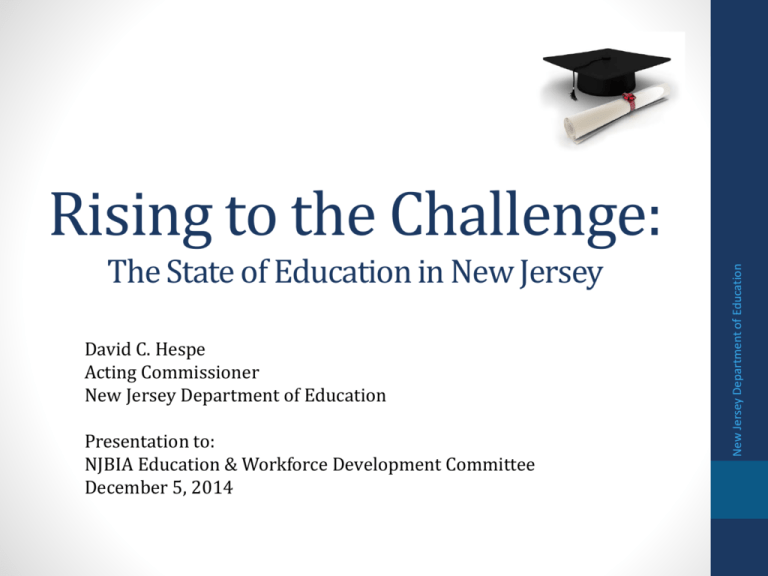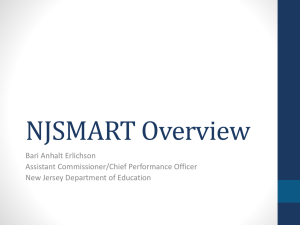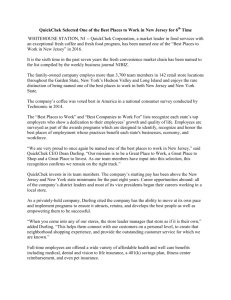NJBIAPresentation
advertisement

The State of Education in New Jersey David C. Hespe Acting Commissioner New Jersey Department of Education Presentation to: NJBIA Education & Workforce Development Committee December 5, 2014 New Jersey Department of Education Rising to the Challenge: Changing Skill Demands New Jersey Department of Education Percent of US Workforce b y EducationalAttainmentLevel Increasing Need for More Education Nationally Source: National Governors Association The “New Minimum” Less than high school 6% Bachelor or above 39% High School 27% Associate Some degree College 7% 23% Source: U.S. Census Bureau, 2012 American Community Survey New Jersey Department of Education Educational Attainment in New Jersey The Mismatch in New Jersey's Talent Pipeline** Current educational attainment & projected industry requirements New Minimum Tomorrow's Demand 55% 45% * * Today's Supply Educational attainment of individuals over 25 in 2010. 58% * 42% * Less Than an Associate Degree Postsecondary Degree * Includes an unknown number of workforce certificates with labor market value that are part of the new minimum. ** The state's current educational attainment is based on the U.S. Census Bureau's American Community Survey, 2010. Projected demand estimates are based on Moody's Analytics forecasts of output by industry and related employment in 2030 multiplied by the state's 2010 post-secondary attainment rate for each industry and summed to produce the projected educational attainment level needed for the state's economy. New Jersey Department of Education Projected industry educational requirements for all new and replacement jobs in 2030 New Jersey’s NAEP Comparisons 2011 2013 4th Grade Reading 2 2 8th Grade Reading 1 1 4th Grade Math 3 4 8th Grade Math 2 2 New Jersey Department of Education Leading the Nation The achievement gap between disadvantaged students and their peers is improving but is still too large. The number of students from all socio-economic backgrounds that leave our schools unprepared for college or career is unacceptable, and this is a drain on their ambition and their potential. New Jersey Department of Education Our Challenges… Achievement Gap: NJASK Math Economically Disadvantaged v. Non-Economically Disadvantaged Proficient and Above 100% 90% 70% 25 24 60% 50% 40% 30% 20% 10% 0% 2009 2010 2011 2012 2013 Econ Dis. 54% 56% 60% 60% 59% Non-Econ Dis 80% 81% 84% 84% 84% New Jersey Department of Education 80% Achievement Gap: NJASK Language Arts White, African American, and Hispanic Students Proficient and Above 100% 90% 70% 60% 33 27 27 31 50% 40% 30% 20% 10% 0% 2009 2010 2011 2012 2013 White 80% 77% 77% 76% 77% African American 47% 46% 45% 45% 46% Hispanic 53% 50% 50% 50% 50% New Jersey Department of Education 80% College Readiness • • • • Essex 8% Bergen 17% Gloucester 22% Camden 14% These rates are within 150% of normal time it takes to get a 2 or 4 year degree Clearly, too many students are unprepared for college level work New Jersey Department of Education Sample of 2013 NJ County College Graduation Rates: College Readiness • • • • • • • Kean NJIT Ramapo Rowan Rutgers Camden Rutgers New Brunswick Montclair State 46% 58% 73% 70% 56% 80% 64% New Jersey Department of Education Sample of 2013 NJ State College Graduation Rates: First-Year Remediation Rates Atlantic Cape 68% Middlesex 79% Bergen 68% Morris 72% Burlington 66% Ocean 62% Camden 74% Passaic 81% Cumberland 63% Raritan 69% Essex 82% Salem 57% Gloucester 63% Sussex 60% Hudson 92% Union 58% Mercer 60% Warren 73% Rutgers – 22% NJ Office of the Secretary of Higher Education, 2012 New Jersey Department of Education NJ County Colleges, 2011 41 New Jersey Department of Education NAEP Outcomes: 12th Grade Reading Meeting the SAT College & Career Readiness Benchmark New Jersey Department of Education NJ Statewide Outcomes 2013 Source: The College Board Grade Level 2009 2010 2011 2012 2013 Difference 2012-2013 NJASK Aggregate 69.2 66.5 66.6 65.9 66.7 0.8 HSPA Aggregate 87.4 89.1 90.7 92.7 93.6 0.9 New Jersey Department of Education English Language Arts (ELA) Proficient and Above, By Grade Goals • They should not need remediation • Those who go to college should graduate, not just ‘attend’ We must close achievement gaps • • Zip-code should not determine likelihood of success Every student should be held to high standards New Jersey Department of Education Students should leave our high schools having mastered the knowledge and skills they need to be successful when they get to college and or their careers Goals Implementation Common Core (2010) Alignment of curriculum & instruction Use of Data Measure Progress To Improve Instruction, Support Schools Through PARCC Assessments (2015) New Jersey Department of Education Vision: Raising Academic Achievement 4 Decades of Standards & Assessments Evolutionary not Revolutionary • 1990s - Core Curriculum Content Standards. Tests in 4th, 8th and 11th grades (HSPA) • 2000s - NJASK testing in grades 3-8; HSPA in 11th with Biology/Algebra end-of-course tests • 2010s - Common Core Standards in Math and Language Arts. PARCC Testing in grades 3-8 with PARCC end-of-course assessments in high school New Jersey Department of Education • 1980s - Basic Skill focus. High School Proficiency Test and Early Warning Test in 8th grade Actionable Information Provide educators with information to improve the classroom: • For professional development • For collaboration among professionals Provide data-hungry parents with : • Information to improve understanding • Whether their child is on track for college/career New Jersey Department of Education PARCC Assessments are designed to… Getting Comfortable with PARCC Flexibility: Allow districts to choose from menu of graduation pathways Flexibility: Teacher evaluations changed to 10% for 2015 New Jersey Department of Education Not a graduation requirement until 2019 at earliest The Final Word: Engage 95% of superintendents report business involvement in schools * But engagement is often inconsistent or isolated In legislature and community: improved standards, assessments, accountability Partner CTE programs, internships, program development Innovate STEAM, technology, choice, early childhood initiatives * Source: ‘Lasting Impact: A Business Leader’s Playbook for Supporting America’s Schools,’ Bill & Melinda Gates Foundation, 2013 New Jersey Department of Education Advocate New Jersey Department of Education





